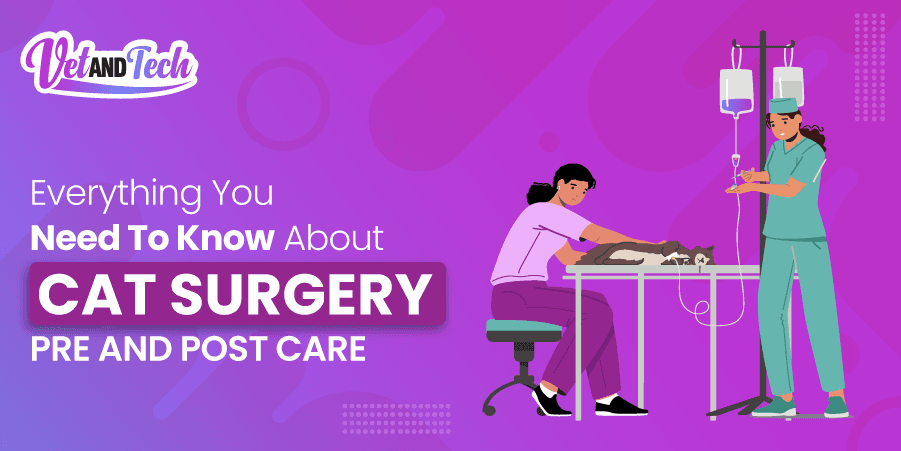Everything You Need To Know About Cat Surgery Pre and Post Care
As a pet owner, you should ensure that your pet stays healthy. Your responsibilities extend beyond simply providing food and shelter. Cats can be finicky regarding their health, especially when visiting the vet, receiving treatment, or undergoing surgical procedures.
It can be overwhelming to learn that your pet requires surgery, but treating and preventing further problems is often necessary. Veterinary surgeries aim to alleviate pain and improve your cat's quality of life by correcting or preventing a health problem. The most important consideration is that your cat will be in a lot of pain and stress before, during, and after the surgery. So, what can you do to assist them during this time?
We will walk you through the entire process so that you can provide the best care for your pet. This blog will go over various aspects of pre-and post-operative cat care.
Cat Pre- and Post-Op Surgical Care: What You Should Know
Most pets will require veterinary surgical procedures at some point in their lives. For example, a cat may need surgery to treat a condition, or it may need to be neutered (spaying or castrating). Most cat operations are now relatively safe with advances in modern medicine and vast improvements in veterinary care standards. Nevertheless, the success of treatment and recovery partially depends on the care the owner provides before and after the procedure.
It is critical to understand how to care for your pet correctly. Follow the steps below to get your pet back to health as soon as possible after surgery.
Preparing Your Cat for Surgery
If the surgery is not an emergency, schedule some time off work to care for your pet. Here are some pointers to help you prepare your cat for the surgery:
• Medication Administration
If your cat is on regular medication, make sure it's safe to give it to the vet. You must also confirm whether your cat requires any additional pre-surgery medication. Keeping your cat's routine as normal as possible before surgery will aid in their comfort. It's natural for cats to be nervous when transported to the vet. Making your cat feel at ease will help the surgery go more smoothly.
• Advice On Food
Another aspect of pet surgery preparation is diet. Some procedures necessitate that pets have an empty stomach, especially those with anesthesia administration. You may need to restrict your cat's eating and drinking for twelve to twenty-four hours before surgery. The veterinarian will confirm this prior to your animal's surgery. It is critical to follow these instructions to avoid complications during surgery for your cat. Vomiting is dangerous when your pet is sedated; you will be asked to fast your pet to reduce the risk.
Caring For Your Cat After Surgery
If you want to get your cat back to normal activities after surgery as soon as possible, ensure they get the best post-op care. Soft tissue surgeries in cats usually result in faster recovery than surgeries involving bones, joints, ligaments, or tendons. However, post-surgical care is usually the same, whether orthopedic surgery, oral surgery, or any other.
Here are a few pointers to keep your cat happy and comfortable while they recover at home:
• Overcoming Anesthesia's Side Effects
The effects of general anesthesia may take some time to wear off. Although common side effects will go away with rest, anesthesia may cause temporary sleepiness or shakiness on cats' feet. Cats recovering from general anesthesia frequently experience a temporary loss of appetite. In addition, it is usual for your cat to be groggy or disoriented for a few hours after anesthesia. The cat may sleep deeper or longer for 24 hours. Discuss any feeding and comfort details with your veterinarian based on the type of anesthetic used and the surgical procedure performed.
• Feeding Your Cat After Surgery
After a surgical procedure, your cat may feel slightly nauseous and lose some appetite. Try to feed cat something small and light after surgery, such as shredded chicken or fish. You can also give them their regular food, but only give them about a quarter of their usual portion. Don't be concerned if your cat stops eating after surgery, but its appetite should return within 24 hours. When your cat's appetite returns, gradually feed them their regular food. If your cat is still not eating after 48 hours, contact your veterinarian, as it could indicate an infection or pain.
• Post-Surgery Pain Management
Your veterinarian will prescribe pain relievers or other medications for your cat to manage its post-operative pain or discomfort. They will explain the appropriate dose, medication administration frequency, and how to do it safely. Follow these veterinarians' instructions to avoid causing your pet unnecessary pain and side effects.
Veterinarians may prescribe antibiotics and pain relievers to prevent infections and further complications. If your cat is anxious or hyperactive, your veterinarian may prescribe a sedative or anti-anxiety medication to help them stay calm during the healing process. Never give human medications to your cat without veterinary consultation, as drugs that make us feel better may harm our pets.
• Keeping Cat Comfortable
To help your cat recover from surgery, give them a quiet and comfortable place to sleep. Protect them from anything that could cause stress, such as other pets or children. Prepare a warm, cozy bed for your cat that will allow them to stretch and relieve any discomfort from surgical areas.
• Limiting Cat Movement
Your veterinarian will most likely advise you to restrict your cat's movement for a while following surgery. Sudden movement can harm the healing process, causing incisions to reopen. You may be wondering how to prevent your cat from jumping following surgery. Sometimes a crate or cage can help your cat recover without complications caused by movement. However, many procedures do not necessitate crates, and many cats do well with staying indoors for a few days while they heal.
• Providing Crate Rest For Your Cat
While most surgeries do not require crate rest for your cat, orthopedic surgery recovery will include strict movement restrictions. If your veterinarian recommends crates, the following steps will help ensure your cat is comfortable in a crate after surgery.
The pet's crate must be spacious enough for him to stand up and turn around. If your cat wears an e-collar to prevent licking, you may need to purchase a larger crate. Leave plenty of space for your cat's water and food dish, as spills can turn your pet's crate into a disaster.
• Taking Care Of Stitches and Bandages
Stitches inserted into your pet's incision will dissolve as the wound heals. If your cat has stitches or staples on the outside of their incision, it will need to be removed by your vet about two weeks after the procedure. Your veterinarian will inform you of the type of stitches used to close your cat's incision and any necessary follow-up care.
Another critical step to ensure the surgical site heals quickly is keeping bandages dry at all times. If your cat goes outside, cover the bandages with cling wrap or a plastic bag to keep wet grass or dampness from getting between the bandage and their skin. Once your pet returns indoors, remove the plastic covering so sweat does not accumulate under the bandage, causing infection.
• Cat's Incision Site
During your cat's recovery from surgery, cat parents may find it difficult to keep their pet from scratching, chewing, or messing around. An e-collar is an excellent way to keep your pet from licking its wound. While most cats adapt to their collars quickly, there are other options if your pet is having a hard time. Discuss with your veterinarian about less frustrating options such as post-op medical pet shirts or donut-style collars.
• Attend The Follow-Up
Follow-up appointments allow your veterinarian to monitor your cat's recovery, check for signs of discomfort or infection, and change your cat's bandages as needed. Bringing your pet in for a check-up allows you to assist in keeping your pet's healing on track.
Wrapping Up
Most cats recover from surgical procedures without complications if they receive the proper care before and after surgery. Sending your beloved pet in for surgery can be frightening, but you can help them by providing pre-and post-operative care to reduce pain and promote a quick recovery. It is also beneficial for you to read about the surgery. Go through the Vet and Tech surgical procedures if you want to learn more about the surgery. It describes common veterinary surgical procedures in detail, which may help you prepare your pet for surgery.
Frequently Asked Questions
What are the most commonly performed cat surgeries?
Spays, neuters, dental procedures, and neurotomy or gastronomy are the most common cat surgeries. Other common cat surgeries include abdominal procedures for foreign bodies, wound management, fracture repairs, and bladder stone removal.
How long does it take to recover from cat surgery?
Depending on the type of procedure, recovery time can vary. Most soft tissue surgeries take approximately ten days for a cat to recover and resume normal activities fully. Some dental procedures need a day or two of rest. Some more extensive surgeries, such as wound repairs and abdominal surgeries, can take up to two weeks.








